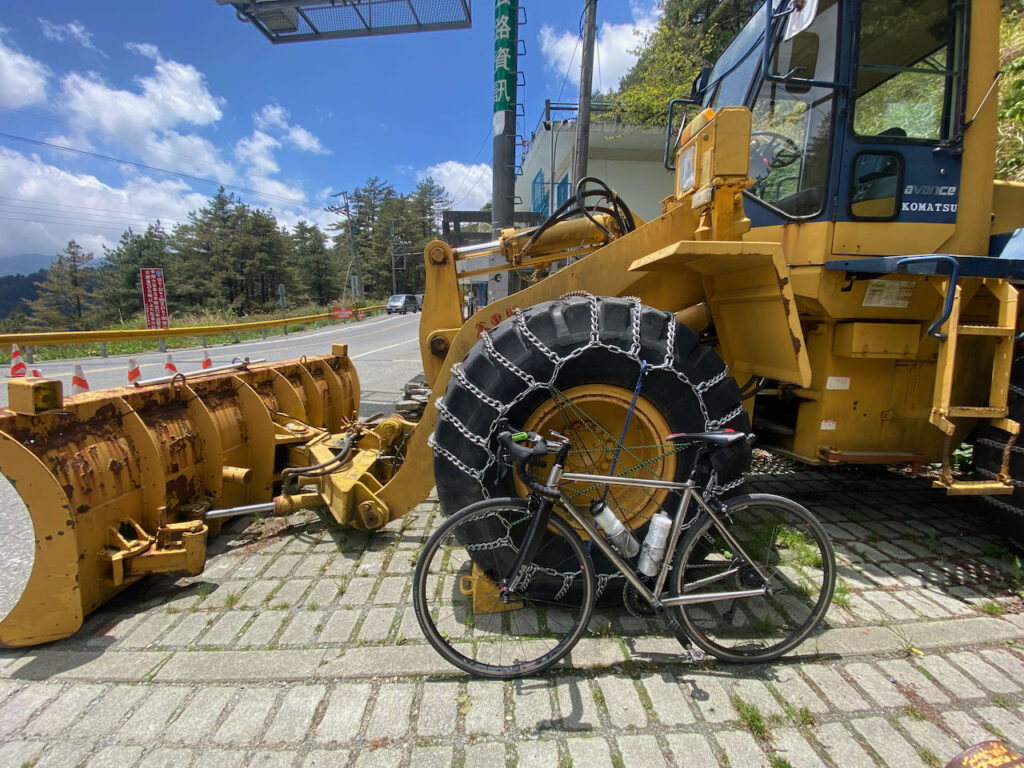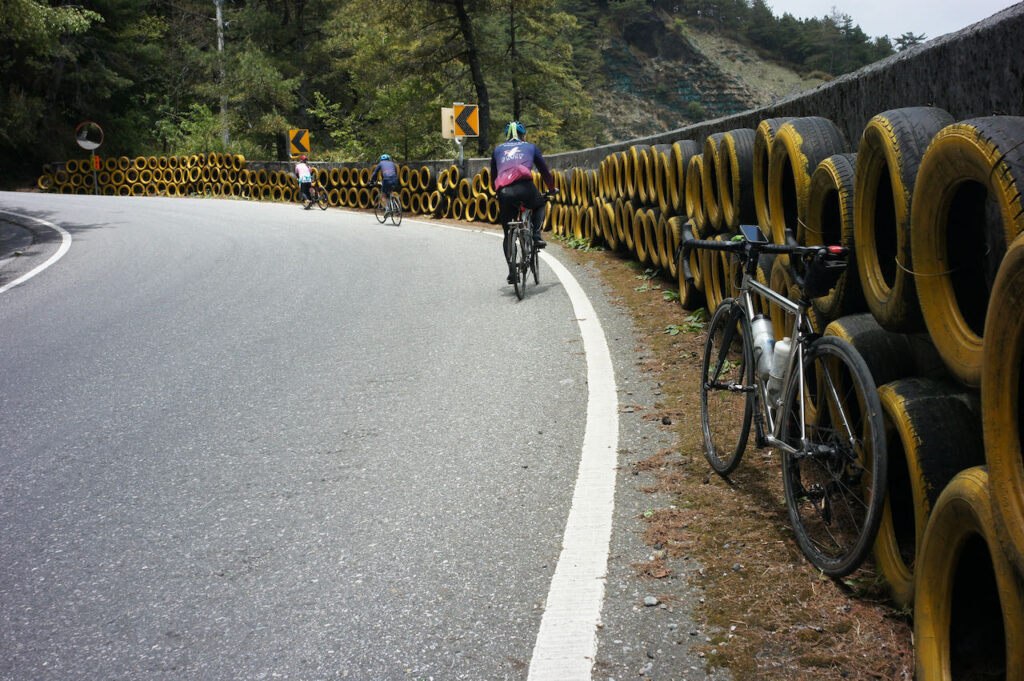


台湾五極点サイクリングは、台湾本島の五つの極点を巡るチャレンジです。これには、最北端、最東端、最南端、最西端 に加え、標高3,275メートルの武嶺という台湾で最も高い舗装道路 が含まれます。このチャレンジを完遂すると、総走行距離は 1,237km に達し、総獲得標高は 11,143m となります。
四極点サイクリングは、すでにクラシック9日間台湾一周よりも難易度の高いルートですが、一部のサイクリストは、さらに過酷な登坂を組み込みたいと考えています。そのため、五つ目の極点として武嶺を追加し、「五極点チャレンジ」として紹介します。
本記事では、最高地点である武嶺に到達するための戦略について解説します。他の四極点については、「台湾四極点サイクリング」をご参照ください。
武嶺に登るベストシーズン
武嶺へ200回以上登った経験を持つ王慎志氏がインタビューで語った内容によると、最適な登坂時期は秋です。この季節は晴天が多く、降水確率が低いため、安定したコンディションで登ることができます。
夏も選択肢の一つ ですが、山頂の気温はそれほど高くないため、比較的快適に登れます。 ただし、午後には雷雨が発生しやすいため、下山は午前中に計画するのが望ましい です。
一方で、春は雨が多く、気温が10℃以下まで下がることがあるため注意が必要 です。
冬は登坂に最も不向きな季節 とされています。雨や霧によって衣服が濡れ、体温が奪われることで大きな負担となります。さらに、真冬には積雪や路面凍結が発生する可能性があり、特に下り区間が危険 になります。


通行止めの可能性と交通規制
旅行を計画する際は、山岳地帯の高速道路での通行止めや交通規制の可能性に注意してください。これらの山岳道路は、台風や地震の影響で損傷を受けることがあります。修復作業は通常迅速に行われますが、完全な復旧には数ヶ月かかる場合もあります。また、工事作業のために道路の一部が封鎖されることがあり、通行可能な時間帯が制限される場合があります。


現在の日付(2023年10月18日)時点で、新城から武嶺にかけての省道8号線の4つの区間で修復作業が行われています。例えば、白沙第二橋付近(179K+500) では、通行可能時間は10:00、11:30、14:00、17:00以降です。觀雲区間(117K+400) では、通行可能時間は07:00 – 08:00、10:00 – 10:10、12:00 – 13:00、15:00 – 15:10、17:00 – 17:10で、それ以外の時間は通行止めとなります。残りの2区間 については、固定された通行時間はなく、通常は片側通行 で、交互に通行が行われています。
これらの通行時間の制限は、ライディングスケジュールに大きく影響 します。計画を慎重に立て、予期せぬ遅延に備えた代替案を準備することが重要です。 山頂付近で足止めされることのないよう注意してください。
最新の道路状況の確認方法については、以下の投稿をご参照ください。
反時計回りで走るための戦略
ルート
武嶺への登坂
台湾五極点サイクリングを反時計回りで走行する場合、花蓮・新城から武嶺への厳しい登坂に挑むことになります。この区間は、総距離87km、獲得標高3,768m に及ぶ厳しいコースであり、KOM(King of the Mountain)レースの主要ルート としても知られ、「東進武嶺」 と呼ばれています。
このルートは距離が長く、補給ポイントが限られているため、計画的に走行することが重要です。1日で登り切れない場合は、途中で宿泊できる場所が2か所あります。最初の選択肢は天祥で、新城から約20km、獲得標高636mの地点にあります。天祥には太魯閣天祥青年活動中心と太魯閣晶英酒店の2つのホテルがあり、7-Elevenも利用できます。
2つ目の選択肢は、標高2,374mに位置する觀雲山荘で、山頂により近いため、宿泊場所として好まれます。觀雲山荘の夕食は特定の時間に提供されるため、食事の時間を逃さないよう注意が必要です。もし夕食の提供時間を逃したり、量が足りないと感じた場合、公式サイトによると、21:30まで営業している売店でインスタントラーメンを購入できます。
最も過酷な区間は、標高2,565mの大禹嶺から武嶺までの最後の10kmです。この時点ではすでに多くの体力を消耗しており、標高が上がるにつれて空気が薄くなるため、さらに厳しい登坂となります。この最後の10.14kmでの獲得標高は767mあり、1kmの下り区間を除くと、残りの登坂区間は常に10%以上の勾配となります。
約5km地点には合歓山サービスステーションがあり、ここが最後の補給ポイントとなります。この地点を過ぎると、武嶺の山頂まで補給できる場所はありません。

しかし、この標高では天候が急変する可能性が高い ことに注意が必要です。もし登坂が厳しすぎると感じたり、悪天候に遭遇した場合、または安全に進むには時間が遅くなりすぎたと判断した場合は、登坂を中止し、梨山へ下山するのが賢明な選択 です。梨山へのルートは30kmの距離で、標高差700mの下り坂 となります。


長く急な下り坂に注意
武嶺への登坂は困難ですが、下りも慎重に進む必要があります。 天候が良く、十分な日照がある場合でも、下り坂にはリスクが伴うため、注意が必要です。下山前に必ずブレーキの状態を確認してください。一部の区間は非常に急勾配で、オートバイや車のブレーキパッドが焼ける匂いが漂うこともあるほどです。特に急なカーブでは、万が一曲がりきれなかった場合に備えて、使用済みのタイヤが壁に設置されている場所もあります。


武嶺からの夜間下山は極めて危険なため、強く推奨されません。 夜間は視界が大幅に制限されるため、通常よりもはるかに低速で下る必要があり、ブレーキシステムへの負担が大きくなります。 安全のために、必ず日中のうちに下山計画を立て、十分な時間を確保 してください。
また、防寒対策も必須 です。一般的に、標高が100m上がるごとに気温は0.65℃低下 します。武嶺の標高は3,275mのため、海抜0m地点よりも気温が約21℃低くなります。
下りでは、登りの時ほど体温を生み出すことができず、下る速度が上がることで風冷効果が強まり、体感温度がさらに低下 します。万が一、下山中に雨が降ると、命の危険にさらされる可能性もあるため、慎重に判断する必要があります。
そのため、大禹嶺から武嶺までの最後の10kmの登坂は、天候が良好な場合にのみ挑戦するのが望ましい です。もし天候が悪化しそうな場合は、大禹嶺から直接梨山へ向かうルートを選ぶことで、安全かつ安定したライドを確保できます。
梨山は観光地としても人気があり、ホテルやレストランが多く、宿泊するには快適な場所 です。
梨山から宜蘭へのルート
梨山から宜蘭への下りは一般的に長く緩やかですが、途中で2つの大きな登りがあるため考慮が必要です。2つの下り(9km、-468m;3.6km、-195m)の後、2つの登り(9km、490m;6.5km、155m)を越えると、思源埡口という峠に到達します。
思源埡口を通過する際は、特に冬や春において気候の大きな変化に備えることが重要です。この山は北東の季節風を遮るため、湿った空気が峠の北側に溜まりやすくなります。その結果、気温が大きく低下し、霧雨や濃霧が発生しやすく、路面が濡れることがあります。こうした状況では、高速での下りが難しくなり、頻繁にブレーキを使用する必要があります。その結果、ブレーキパッドが早く摩耗しやすく、特に水分とともにブレーキ面に砂が付着すると、さらに摩耗が進みます。予備のブレーキパッドを携行することが安全な選択となり、安心につながります。

時計回りで走るための戦略
ルート
このルートを時計回りで進む場合、北の極点(富貴角) と 東の極点(三貂角) を訪れた後、宜蘭から省道7号線および7甲(7A)を経由して武嶺へ向かう過酷な登坂が続きます。このルートは「北進武嶺」とも呼ばれています。
梨山と宜蘭の間には、省道7甲(7A)沿いに点在する宿泊施設 があります。宿泊を予約する際は、近くにレストランがないため、食事の提供があるかを必ず確認してください。補給ポイントとしては、太平に1軒の食料品店、南山部落に1軒のファミリーマート、黄山部落に1軒のセブンイレブンがあります。これらを利用しながら、標高を上げて梨山へ向かいます。
梨山は武嶺への最後の登坂(40km、獲得標高1,474m)の出発点であるため、宿泊地として最適 とされています。この距離自体は長くありませんが、次の宿泊施設までの移動を考慮し、しっかりと計画を立てることが重要です。
大禹嶺に到達し、象徴的な「合歓山トンネル」を通過すると、反時計回りルートと合流 し、前述の過酷な10kmの登坂 を含むルートとなります。また、武嶺からの下山は特に注意が必要 です。これは、大禹嶺までの急な10kmの下りだけでなく、大禹嶺から新城までの長い下り(標高3,022mの下降、77km)にも当てはまります。もし海抜0m地点に到達する前に宿泊が必要な場合は、観雲山荘を検討してください。あるいは、新城駅や花蓮の北埔駅に到着すれば、複数のホテルオプションがあります。


花蓮403地震後の代替ルート
台北から北東へ向かい、東の極点(三貂角) に到達した後、美しい海岸線を反時計回り に走り、北の極点(富貴角) を訪れます。この2つの極点を制覇した後、台北へ戻り、河岸自転車道を経由して桃園へ向かいます。そこから、北横公路を登り、宜蘭の大同郷を経由して、省道7甲(7A)を通り梨山へ向かいます。
梨山を過ぎると、武嶺に到達するまでホテルがほとんどないため、ここで一泊するのが推奨 されます。その後、武嶺を越え、清境または埔里でさらに一泊するのが一般的です。
提案ルートでは、西海岸へ向かい、西の極点(国聖灯台)と南の極点(鵝鑾鼻灯台) を訪れるよう案内しています。ただし、山岳ルートを通って南下するルートを選択しても問題ありません。
ルート パート1:
- Garmin: https://connect.garmin.com/modern/course/262125352
- Velodash: https://velodash.page.link/oETa
- komoot: https://www.komoot.com/tour/1522669141
ルート パート2:
